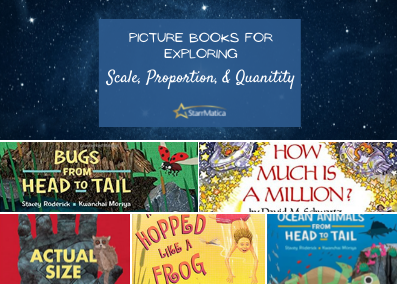Picture books are a great way to get students to examine the crosscutting concepts of the Next Generation Science Standards. New to the crosscutting concepts? Here’s a quick summary! The crosscutting concepts are one of the three dimensions of the NGSS. The seven crosscutting concepts are lenses through which your students can examine different phenomena. Using the CCC helps students to better understand both known and unfamiliar phenomena, so it can be worthwhile to spend some time helping them to dig in and really understand what each concept means. Using picture books can help make the CCC accessible to students of all ages!
The picture books shared below are fantastic for examining the crosscutting concept of Scale, Proportion, and Quantity. Whether you are reading them aloud, having students explore them in small groups, or having students read them independently, the following questions can be used to help students focus on scale, proportion, and quantity:
- How long is _______ ?
- How much does ______ weigh?
- What is the temperature of __________ ?
- How does this measurement compare to___________?
- What scale should be used to investigate the mechanisms at work in this system? Why is that the right scale for this system?
- How could we test whether _________ is changing, even though it looks like it is not?
 Stacey Roderick’s From Head to Tail texts are a series that seems specifically designed for an exploration of scale with younger students. The illustration are key to these texts which ask students to predict what animal a certain body part belongs to. The body part is first shown at a larger “close up” scale before being shown as part of the larger animal. The series includes:
Stacey Roderick’s From Head to Tail texts are a series that seems specifically designed for an exploration of scale with younger students. The illustration are key to these texts which ask students to predict what animal a certain body part belongs to. The body part is first shown at a larger “close up” scale before being shown as part of the larger animal. The series includes:
- Bugs From Head to Tail
- Ocean Animals From Head to Tail
- Dinosaurs From Head to Tail
- Birds From Head to Tail
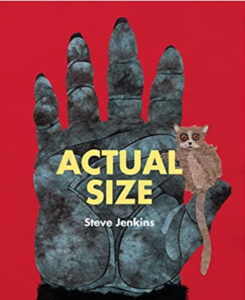 Actual Size by Steve Jenkins is one of my favorites for discussions about scale because of the concrete way the illustrations allow students to view parts of animals in their actual size. This book is sure to inspire students to create projects that show the “actual size” of animals not included in the book. An interesting cross-curricular connection to Social Studies can be made by using this interactive map to explore the “actual size” of countries around the world.
Actual Size by Steve Jenkins is one of my favorites for discussions about scale because of the concrete way the illustrations allow students to view parts of animals in their actual size. This book is sure to inspire students to create projects that show the “actual size” of animals not included in the book. An interesting cross-curricular connection to Social Studies can be made by using this interactive map to explore the “actual size” of countries around the world.
These “actual size” resources can also spark discussion of how to represent large areas of land and bodies of water on a map while exploring NGSS Performance Expectation: 2-ESS2-2 – Develop a model to represent the shapes and kinds of land and bodies of water in an area.
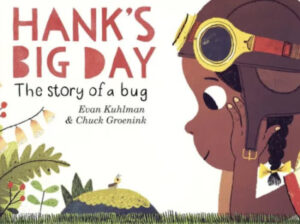
Hank’s Big Day: The story of a bug by Evan Kuhlman is an excellent text for exploring scale because the illustrations switch back and forth from the perspective of an ant to the perspective of a young boy. You could make an authentic connection to art by asking your students to draw the same object from the perspective of an ant and the perspective of a human. Have them try this challenge both before and after reading the text to see how their perspective on perspective has grown!
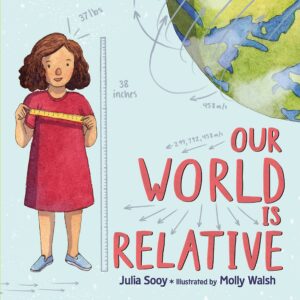
Our World is Relative by Julia Sooy is a book specifically written to help students understand that our perceptions large and small, fast and slow, hot and cold, etc. are all relative. A lake is large until you compare it to the ocean. A car is fast until you compare it to an airplane. Before reading, get your students engaged by asking them if Earth is large or small and how do they know? (Because it can be both depending on what you are comparing it to!) After reading the text, challenge your students to think of comparisons that make one object both fast and slow or big and small depending on what you compare it to.
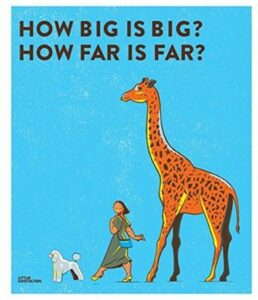
How Big is Big? How Far Is Far? by Dorothee Soehlke-Lennert is similar to the previous text in its focus. How heavy, how big, how fast or how old something is depends on the scale being used for comparison. This text drives that fact home with many examples and illustrations to help students understand that measurements are relative. After reading, ask your students: Why does the scale you are using matter when measuring something?
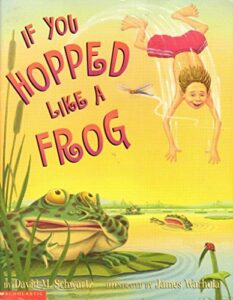
If You Hopped Like a Frog by David Schwartz makes a discussion of proportion accessible for all students. The amusing illustrations engage students in imagining what they could do if they had abilities proportional to those in the animal kingdom. For example, if you were as strong as an ant, you could lift a car!
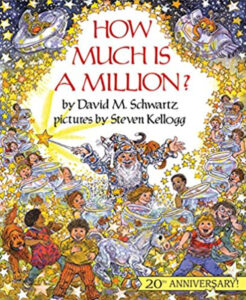
How Much is A Million by Steven Kellogg is a classic picture book that helps students to understand the quantity of one million by showing what one million means in different contexts – such as students standing on each others’ shoulders or the amount of time it would take to count to one million.

A Hundred Billion Trillion Stars by Seth Fishman is another picture book for exploring quantity. While it doesn’t lend itself to helping students understand really large numbers, it does get them to think about large quantities. And it could be used as a launching pad for thinking about how almost everything in the world can be measured and quantified in multiple ways. For example, how many different ways can you measure an ant? How can you use a proportional relationship to compare your measurements to another object?
If you are a StarrMatica Texts: Science Your Way subscriber, you can check out the texts below that align with an exploration of scale, proportion, and quantity. Remember, each 1st – 5th grade text has multiple reading levels so all of your students can read the same content independently.
- Second grade: It’s All Water; Water, Water Everywhere
- Fifth grade: Star Bright; Star Power; The World of Water; Where in the World is Our Water; Small, Smaller, Smallest; The Size of Matter
Not a subscriber? Click here for a free trial to access the texts above.
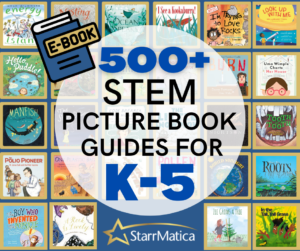 And if you are looking for additional picture books for your science classroom, check out the Perfect Picture Book Pairing Series that includes one-page guides with activities and discussion questions for hundreds of STEM-themed picture books aligned to every NGSS performance expectation!
And if you are looking for additional picture books for your science classroom, check out the Perfect Picture Book Pairing Series that includes one-page guides with activities and discussion questions for hundreds of STEM-themed picture books aligned to every NGSS performance expectation!
CLICK HERE TO PREVIEW THE PERFECT PICTURE BOOK PAIRING EBOOKS
Be sure to check out the other posts in this series to discover picture books to highlight each of the seven crosscutting concepts in the NGSS!
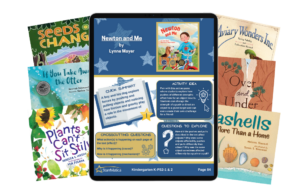
Want to save even more time with lesson ideas for 35 picture books that you can use to highlight all seven crosscutting concepts?
Enter your information below to receive your complimentary picture book guides including activity ideas, science questions, and crosscutting concept questions!

